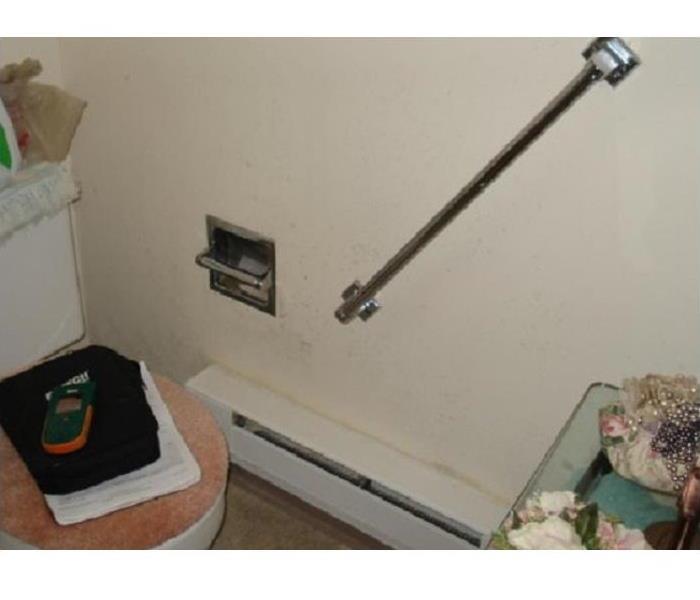Archived Mold Remediation Blog Posts
Checking For Mold
2/3/2020 (Permalink)
We all know Spring is when the real estate market "blossoms" with new listings, all new and sparkling after a long winter. Maybe you've spent time cleaning, painting and otherwise preparing your house for sale. What you may have overlooked though, is the presence of mold and/or moisture stains that can suggest mold is present. This would be a red flag to any buyer and could stop a sale in its tracks, if not handled properly.
Understanding Mold
Mold spores occur naturally almost everywhere, both indoors and outdoors. These microscopic spores float along in the air and can enter a home or business through windows and HVAC systems.
Consider these facts:
-Mold is present almost everywhere, indoors and outdoors.
-Mold spores thrive on moisture.
-Mold spores can quickly grow into colonies when exposed to water. These colonies may produce allergens and irritants.
Before mold remediation can begin, any sources of water or moisture must be addressed. Otherwise, the mold may return. Mold often produces a strong, musty odor and can lead you to possible mold problem areas. Even higher-than-normal indoor humidity can support mold growth. Keep indoor humidity below 45 percent.
Our highly trained Project Managers use state-of-the-art technology to take moisture readings that can indicate the likelihood of mold.
Armed with that knowledge, you can then make an informed decision on the next steps for the sale of your home.
If you think you have mold, or have any other mold-related questions, don't hesitate to call SERVPRO of Danvers/Ipswich at 978-356-7077.
Key to Avoiding Future Mold Problems
1/24/2020 (Permalink)
After you have suffered through the disaster water damage can leave behind, you may sigh a breath of relief and think the worst is over. Unfortunately, if not mitigated correctly, the worst may be yet to come.
When it comes to water damage, the key to avoiding future mold problems is time. The quicker you can get to the source, fix the problem, and begin the drying (or demolition) the better.
Brian Carifio, a Project Estimator here at SERVPRO of Danvers/Ipswich, recommends waiting no longer than 3 days to address the mold risk.
He also recommends the following steps
Dry out the affected area. Once the water has been extracted, use fans and a dehumidifier to help dry out the area. If possible, open windows to allow for air circulation and faster drying. You want to dry the area out as soon as possible. If you have a finished basement and the drywall was affected, you’ll probably have to cut away the areas that were touched by water as the drywall will crumble and the paper backing is a good source of food for mold. If you have baseboard trim, take it up first, and if it’s made from pressboard it will likely not be salvageable. If it was wood, you might be able to save it.
Disinfect. This is a crucial step that is often overlooked. After the area has dried out, including wood beams, insulation, drywall, etc., use a good disinfectant to get rid of any bacteria that might have come up through sewers, toilets, etc. Disinfect all areas affected by the floodwaters including walls and wood and non-upholstered furniture that sat in floodwater.
SERVPRO of Danvers/Ipswich uses proprietary, OSHA-approved cleaning agents that may be needed to clean and remove odors and/or contaminants on your property.
- Deodorization products control odors from excessive moisture.
- Disinfection products stop the growth of bacteria, fungi, mildew, and other harmful microorganisms.
Dispose of damaged items responsibly: you’ll be tempted to throw everything into a dumpster and send it all away and out of sight. But if you can organize damaged goods into piles and take what you can to recycling centers, you will help alleviate the pressure on your local landfill site. Go to your city or town’s waste management website to find out where to recycle old paints, stains, adhesives and other toxic liquids, any damaged electronics from cell phones to TVs and computers, furniture, and even drywall.
Mold Prevention
1/21/2020 (Permalink)
Mold in your Home
Mold is a natural part of our environment. It helps our ecosystem function by breaking down organic matter.
Mold grows best in warm, damp, and humid conditions. Mold can grow in 24-48 hours in the right conditions. There is no way to eliminate mold spores from the air, but there are precautions that can be taken to avoid the growth of indoor mold. Bathrooms are the perfect breeding ground for mold. When the weather permits, keep a window open in the bathroom when using the shower to reduce moisture. Hang towels to dry, and wipe down your tub, shower, and walls after showering. Eliminating moisture is your best defense against mold growth. If your bathroom has an exhaust fan, use it during baths and showers.
Keep an eye on humidity levels in your home and be sure to check various places in your home for moisture. Mold often grows on foundation walls and surfaces in the basement. It can also grow on carpets, floors, walls, and furniture. Clean up spills immediately and inspect your home for leaks. Be sure to empty drip trays from your appliances such as refrigerators, air conditioners, and dehumidifiers.
We hope these tips can help keep mold from growing in your home, but if you find yourself with a mold problem, SERVPRO of Danvers/Ipswich is always here to help. We can remediate the mold and bring your home back to healthy living conditions. Give us a call if we can be of assistance. 978-356-7077
A Bathroom Fan - Helpful or Not?
1/2/2020 (Permalink)
A properly installed vent fan is an essential weapon against bathroom mold.
We all know mold likes moisture. That’s why bathrooms are so vulnerable to mold. Water that gets onto the bathroom floor is an obvious concern. Of even greater concern is moisture in the air –moisture that can permeate wall and ceiling materials because of poor bathroom ventilation.
When the bathroom fills with a fog of moist air while taking a hot shower, thousands of moisture droplets can condense on cool wall, ceiling and window surfaces in the bathroom and also in adjacent rooms. Some of this moist air can even penetrate into unseen building cavities through cracks and gaps around electrical outlets and molding. Because damp organic material (wood, paper-faced wallboard, paint resins, paper-faced fiberglass insulation) makes ideal mold food, we have the makings of a mold invasion.
Vent fan to the rescue–or not?
The bathroom vent fan is a major weapon against bathroom mold. The fan’s job is to move moist air outside the house before it can condense and permeate into mold-prone materials.
However, some builders mistakenly allow the fan to blow moist air into the attic, a practice that simply moves the mold problem to another part of the house. During cold weather, warm, moist air blown into a cooler attic will deposit its moisture on attic rafters and roof sheathing. Telltale black mold stains typically result from this ventilation error. Eventually, this mold can develop into wood rot.
When you find mold
Mold spreads quickly, so a minor mold infestation can quickly escalate into a major problem. SERVPRO of Danvers/Ipswich is dedicated to responding immediately when you contact us. A fast response lessens the damage, limits further damage, and reduces cost.
We specialize in water and mold damage restoration, the cornerstone of our business. We have the training and expertise to safely handle any mold situation.
- Applied Microbial Remediation Specialist
- Water Damage Restoration Technician
- Applied Structural Drying Technician
Our advanced equipment helps to detect and stop the source of water feeding the mold. We then isolate the affected area using a negative air pressure chamber.
Call Us! We Can help! 978-356-7077
Mold In Your Home?
12/6/2019 (Permalink)
Mold is one of those words that can strike fear and send you fleeing to pack your bags. Before you send the "We're Moving" postcards, learn the ABC's of mold in your home.
Mold In Your Home
Mold is airborne and can enter your home through open doorways, windows, vents, and heating and air conditioning systems. Mold in the air outside can also attach itself to clothing, shoes, bags, and pets can and be carried indoors.
It will grow in places with a lot of moisture, such as around leaks in roofs, windows, or pipes, or where there has been flooding. Mold grows well on paper products, cardboard, ceiling tiles, and wood products. Mold can also grow in dust, paints, wallpaper, insulation, drywall, carpet, fabric, and upholstery.
What Can You Do?
Inside your home you can control mold growth by:
- Controlling humidity levels;
- Promptly fixing leaky roofs, windows, and pipes;
- Thoroughly cleaning and drying after flooding;
- Ventilating shower, laundry, and cooking areas.
If mold is growing in your home, you need to clean up the mold and fix the moisture problem.
SERVPRO of Danvers/Ipswich specializes in water and mold damage restoration, the cornerstone of our business. We have the training and expertise to safely handle any mold situation.
- Applied Microbial Remediation Specialist
- Water Damage Restoration Technician
- Applied Structural Drying Technician
To learn more, click here or call 978-356-7077
Bathroom Mold
2/18/2019 (Permalink)
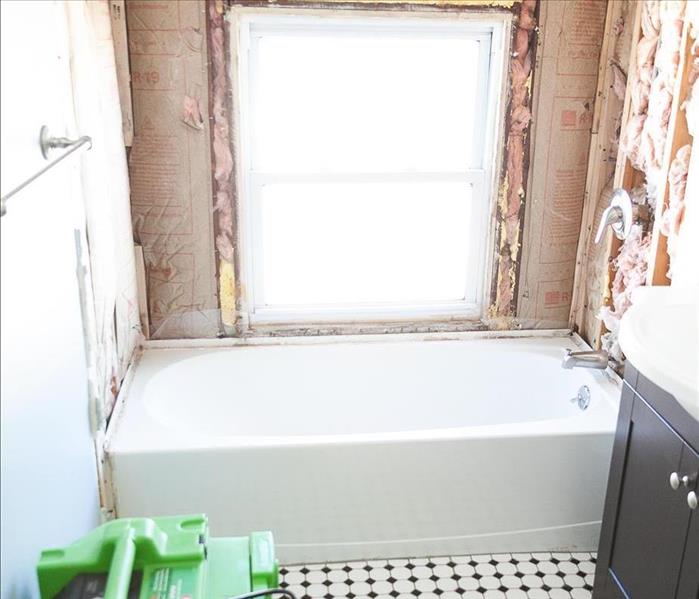 This photo was taken after our crews removed the affected drywall.
This photo was taken after our crews removed the affected drywall.
Mold in the Shower
When a shower tile popped off of the wall in this homeowner's bathroom, she discovered that there was mold growing behind it. As more tiles were pulled off, mold was discovered on the entire wall behind all of the tiles. She called in the experts from SERVPRO of Danvers/Ipswich to remediate the damage. We specialize in water and mold damage restoration, with advanced training in restoration techniques and the experience and specialized equipment to quickly restore your property.
Another Happy Customer
Here's what she had to say after the job was complete:
"We recently had a small mold issue in our bathroom that we weren't sure would be covered by insurance. Pat Lavigne was incredibly helpful in advising us of the process to get the project underway. Justin, the crewmember that did the remediation, was very respectful and conscientious. He communicated with us every step of the way and his workmanship was almost "surgical" in the way he took care to demo only the affected area."
Conditions in Danvers Might Be Right for Mold
2/15/2019 (Permalink)
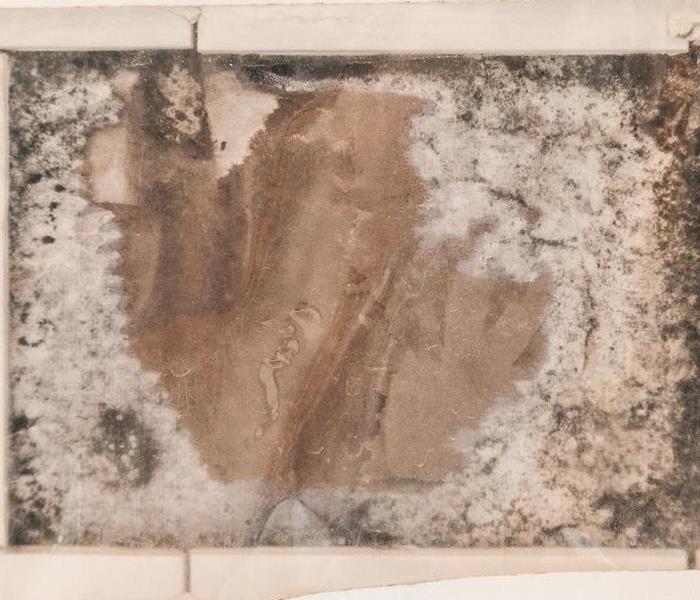 An image of mold in a residential home.
An image of mold in a residential home.
It’s estimated that more than 1 million types of mold exist, yet less than 10 percent have actually been named. This means mold is very common in both indoor and outdoor environments. While mold and humans can sometimes co-exist without issue, there are certain species of mold that can cause health effects for some people.
If the right conditions exist, mold will grow. Those conditions include:
- Water - Different mold types require varying amounts of liquid before growth begins.
- Temperature - Normal indoor temperatures will promote mold growth.
- Time - Initial mold colonizers can take hold within one day after being exposed to an adequate water supply.
Mold growth can occur in any home, so it’s important to keep an eye out for situations that might promote mold activity. Roof/chimney leaks, wet basements, or condensation from ducts that dampen surrounding insulation are just a few examples of issues that make a house a prime target for mold growth.
If you suspect mold in your home, call SERVPRO of Danvers/Ipswich to assess the situation. We have the knowledge, tools and track record to effectively remediate mold in your home or business.
If you suspect mold, call us today at 978-356-7077.
What to Do:
- Stay out of affected areas.
- Turn off the HVAC system and fans.
- Contact SERVPRO of Danvers/Ipswich for mold remediation services.
Danvers Residents: Follow These Mold Safety Tips if You Suspect Mold
2/11/2019 (Permalink)
 Be careful, without proper training, you could be spreading mold throughout your home.
Be careful, without proper training, you could be spreading mold throughout your home.
If you see visible mold, do not disturb it. You can inadvertently spread the mold infestation throughout your home. When mold is disturbed, the mold can release microscopic mold spores which become airborne and can circulate inside your home.
What to Do:
- Stay out of affected areas.
- Turn off the HVAC system and fans.
- Contact SERVPRO of Danvers/Ipswich for mold remediation services.
What Not to Do:
- Don’t touch or disturb the mold.
- Don’t blow air across any surfaces with visible or suspected mold growth.
- Don’t attempt to dry the area yourself.
- Don’t spray bleach or other disinfectants on the mold.
About Our Mold Remediation Services
SERVPRO of Danvers/Ipswich specializes in mold cleanup and restoration, in fact, it’s a cornerstone of our business. Our crews are highly trained restoration professionals that use specialized equipment and techniques to properly remediate your mold problem quickly and safely.
If You See Signs of Mold, Call Us Today – 978-356-7077
Mold Prevention in Your Home
1/11/2019 (Permalink)
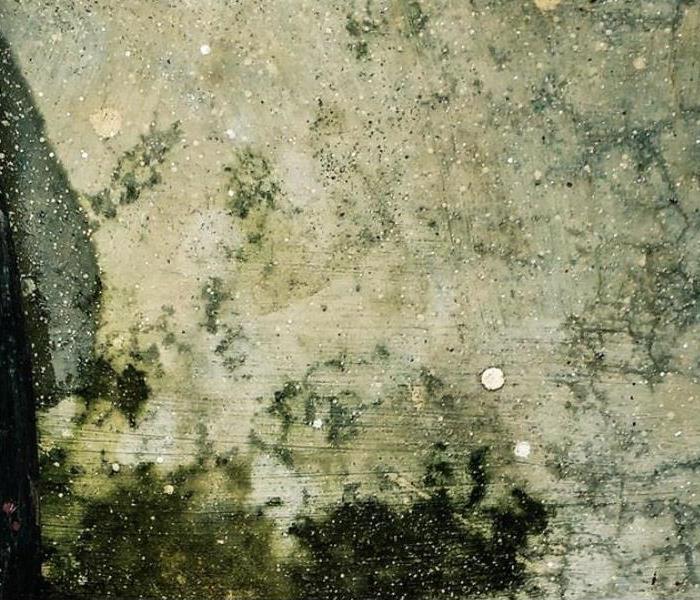 You can help prevent mold in your home.
You can help prevent mold in your home.
Mold in Your Home
Mold is a natural part of our environment. It helps our ecosystem function by breaking down organic matter. However, it is unhealthy to have mold growing inside of our homes. According to the CDC, exposure to damp and moldy environments may cause a variety of health effects or none at all. Some people are sensitive to molds. For these people, molds can cause nasal stuffiness, throat irritation, coughing or wheezing, eye irritation, or, in some cases, skin irritation.
Mold grows best in warm, damp, and humid conditions. Mold can grow in 24-48 hours in the right conditions. There is no way to eliminate mold spores from the air, but there are precautions that can be taken to avoid the growth of indoor mold. Bathrooms are the perfect breeding ground for mold. When the weather permits, keep a window open in the bathroom when using the shower to reduce moisture. Hang towels to dry, and wipe down your tub, shower, and walls after showering. Eliminating moisture is your best defense against mold growth. If your bathroom has an exhaust fan, use it during baths and showers.
Keep an eye on humidity levels in your home and be sure to check various places in your home for moisture. Mold often grows on foundation walls and surfaces in the basement. It can also grow on carpets, floors, walls, and furniture. Clean up spills immediately and inspect your home for leaks. Be sure to empty drip trays from your appliances such as refrigerators, air conditioners, and dehumidifiers.
We hope these tips can help keep mold from growing in your home, but if you find yourself with a mold problem, we're here to help. We can remediate the mold and bring your home back to healthy living conditions.
Does your Ipswich Home Have a Mold Problem?
12/26/2018 (Permalink)
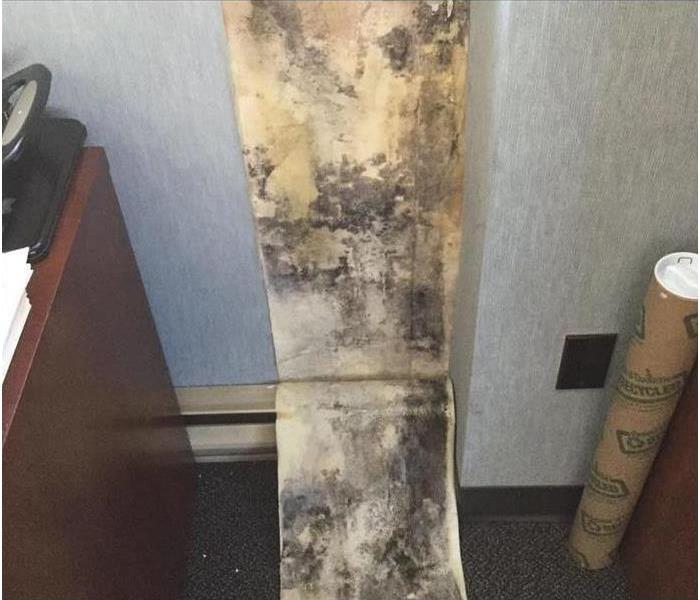 Mold was found in this Amesbury office building and SERVPRO of Danvers/Ipswich remediated the mold.
Mold was found in this Amesbury office building and SERVPRO of Danvers/Ipswich remediated the mold.
With window and doors open now, with the nice weather, many types of particles have free access to float into your home. Mold can spread through a home in as little as 48 hours.
Microscopic mold spores naturally occur almost everywhere, both outdoors and indoors. This makes it impossible to remove all mold from a home or business. Therefore, mold remediation reduces the mold spore count back to its natural or baseline level. Some restoration businesses advertise “mold removal” and even guarantee to remove all mold, which is a fallacy. Consider the following mold facts:
- Mold is present almost everywhere, indoors and outdoors.
- Mold spores are microscopic and float along in the air and may enter your home through windows, doors, or AC/heating systems or even hitch a ride indoors on your clothing or a pet.
- Mold spores thrive on moisture. Mold spores can quickly grow into colonies when exposed to water. These colonies may produce allergens and irritants.
- Before mold remediation can begin, any sources of water or moisture must be addressed. Otherwise, the mold may return.
- Mold often produces a strong, musty odor and can lead you to possible mold problem areas.
- Even higher-than-normal indoor humidity can support mold growth. Keep indoor humidity below 45 percent.
If your home or business has a mold problem, we can inspect and assess your property and use our specialized training, equipment, and expertise to remediate your mold infestation.
If You See Signs of Mold, Call Us Today – (978) 777-3498
Are You Selling A House With Mold?
5/8/2018 (Permalink)
 Notice the dark moisture stains on the back wall. This suggested mold was present. We began remediation by drying the air with a dehumidifier.
Notice the dark moisture stains on the back wall. This suggested mold was present. We began remediation by drying the air with a dehumidifier.
We all know Spring is when the real estate market "blossoms" with new listings, all new and sparkling after a long winter. Maybe you've spent time cleaning, painting and otherwise preparing your house for sale. What you may have overlooked though, is the presence of mold and/or moisture stains that can suggest mold is present. This would be a red flag to any buyer and could stop a sale in it's tracks, if not handled properly.
Understanding Mold
Mold spores occur naturally almost everywhere, both indoors and outdoors. These microscopic spores float along in the air and can enter a home or business through windows and HVAC systems.
Consider these facts:
- Mold is present almost everywhere, indoors and outdoors.
- Mold spores thrive on moisture. Mold spores can quickly grow into colonies when exposed to water. These colonies may produce allergens and irritants.
- Before mold remediation can begin, any sources of water or moisture must be addressed. Otherwise, the mold may return.
- Mold often produces a strong, musty odor and can lead you to possible mold problem areas.
- Even higher-than-normal indoor humidity can support mold growth. Keep indoor humidity below 45 percent.
Our highly trained Project Managers use state-of-the-art technology to take moisture readings that can indicate the likelihood of mold.
Armed with that knowledge, you can then make an informed decision on next steps for the sale of your home.
If you think you have mold, or have any other mold related questions, don't hesitate to call us. 978-777-3498.
The Bathroom Fan - Friend or Foe?
3/8/2018 (Permalink)
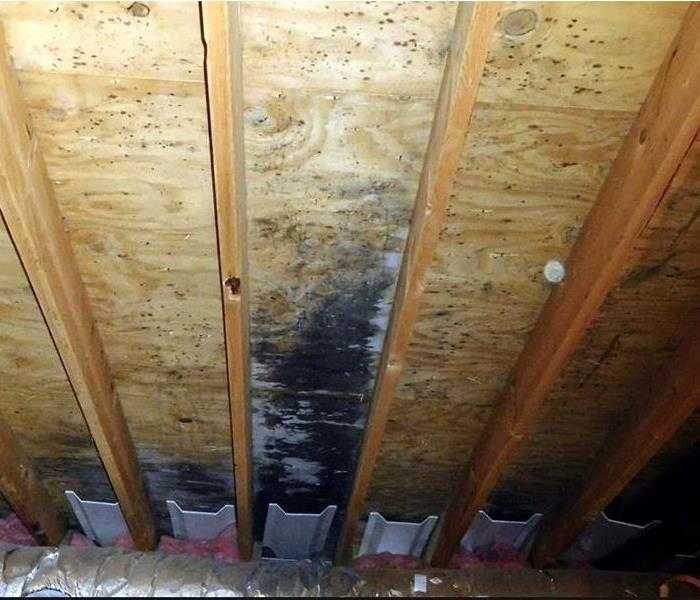 Attic mold found due to an improperly vented bathroom fan.
Attic mold found due to an improperly vented bathroom fan.
A properly installed vent fan is an essential weapon against bathroom mold.
We all know mold likes moisture. That’s why bathrooms are so vulnerable to mold. Water that gets onto the bathroom floor is an obvious concern. Of even greater concern is moisture in the air –moisture that can permeate wall and ceiling materials because of poor bathroom ventilation.
When the bathroom fills with a fog of moist air while taking a hot shower, thousands of moisture droplets can condense on cool wall, ceiling and window surfaces in the bathroom and also in adjacent rooms. Some of this moist air can even penetrate into unseen building cavities through cracks and gaps around electrical outlets and molding. Because damp organic material (wood, paper-faced wallboard, paint resins, paper-faced fiberglass insulation) makes ideal mold food, we have the makings of a mold invasion.
Vent fan to the rescue–or not?
The bathroom vent fan is a major weapon against bathroom mold. The fan’s job is to move moist air outside the house before it can condense and permeate into mold-prone materials.
However, some builders mistakenly allow the fan to blow moist air into the attic, a practice that simply moves the mold problem to another part of the house. During cold weather, warm, moist air blown into a cooler attic will deposit its moisture on attic rafters and roof sheathing. Telltale black mold stains typically result from this ventilation error. Eventually, this mold can develop into wood rot.
When you find mold
Mold spreads quickly, so a minor mold infestation can quickly escalate into a major problem. SERVPRO of Danvers/Ipswich is dedicated to responding immediately when you contact us. A fast response lessens the damage, limits further damage, and reduces cost.
We specialize in water and mold damage restoration, the cornerstone of our business. We have the training and expertise to safely handle any mold situation.
- Applied Microbial Remediation Specialist
- Water Damage Restoration Technician
- Applied Structural Drying Technician
Our advanced equipment helps to detect and stop the source of water feeding the mold. We then isolate the affected area using a negative air pressure chamber.
Call Us! We Can help! 978-777-3498
Mold Removal vs. Remediation
3/8/2018 (Permalink)
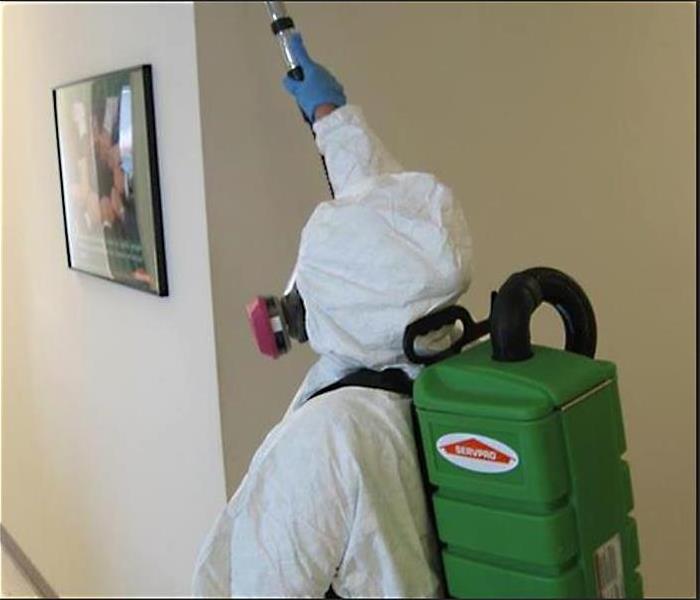 A SERVPRO crew member during the mold remediation process.
A SERVPRO crew member during the mold remediation process.
Can Mold Be Removed?
Simply put…no. Microscopic mold spores exist naturally almost everywhere, indoors and outdoors, so removing all mold from a home or business is impossible. Any claim otherwise is a fallacy.
Consider the following mold facts:
- Mold is present almost everywhere, indoors and outdoors.
- Mold spores are microscopic and float along in the air, and they may enter your home through windows, doors, or AC/heating systems or even hitch a ride indoors on your clothing or a pet.
- Mold spores thrive on moisture. Mold spores can quickly grow into colonies when exposed to water.
- Before mold remediation can begin, any sources of water or moisture must be addressed. Otherwise the mold may return.
- Let your nose lead the way. Mold often produces a strong, musty odor, and can lead you to possible mold problem areas.
- Even higher than normal indoor humidity can support mold growth. Keep indoor humidity below 45 percent.
The Remediation Process
Every mold damage scenario is different and requires a unique solution, but the general mold remediation process stays the same. The steps listed below illustrate our “typical” process:
- Emergency Contact - (978) 777-3498
The mold cleanup and restoration process begins when you call us. Our representative will ask a series of questions to help us determine the necessary equipment, resources, and personnel.
- Inspection and Mold Damage Assessment
We carefully inspect your property for visible signs of mold. Mold feeds on cellulose and water and can be hidden from plain view. We use various technologies to detect mold and hidden water sources.
- Mold Containment
Our professionals use various containment procedures to prevent the spread of mold. We may use advanced containment procedures like negative air chambers to isolate the contaminated area with physical barriers and negative air pressure to keep the mold spores from spreading during the cleanup process. All fans and heating and cooling systems will be turned off to prevent the spread of mold.
- Air Filtration
Our specialized filtration equipment allows our Professionals to capture microscopic mold spores out of the air. We utilize powerful “air scrubbers” and HEPA vacuums to prevent the spread of these mold spores while the mold remediation is in process.
- Removing Mold and Mold-Infested Materials
The mold remediation process depends on the amount of mold growth and the types of surfaces on which the mold appears. We’ll use antifungal and antimicrobial treatments to eliminate mold colonies and to help prevent new colonies from forming. It may be necessary to remove and dispose of mold-infested porous materials, like drywall and carpeting, to remediate heavy mold growth.
- Cleaning Contents and Belongings
We clean your furniture, decorative items, curtains, clothing, and other restorable items affected by mold. We use a variety of cleaning techniques to clean and disinfect your belongings. We’re also trained to remove odors and deodorization using fogging equipment.
- Restoration
Depending on the level of mold damage, drywall, subfloors, and other building materials may have been removed. Restoration may involve minor repairs, such as replacing drywall, painting, and installing new carpet; or it may entail major repairs such as the reconstruction of various areas or rooms in a home or business. The restoration step gets your home or business back to normal.
If you suspect you have mold, call us today. We're here to help!
Mold In Your Home
2/13/2018 (Permalink)
Mold is one of those hot button words that can strike fear and send you fleeing to pack your bags. Before you send the "We're Moving" postcards, learn the ABC's of mold in your home.
Mold In Your Home
Mold is airborne and can enter your home through open doorways, windows, vents, and heating and air conditioning systems. Mold in the air outside can also attach itself to clothing, shoes, bags, and pets can and be carried indoors.
It will grow in places with a lot of moisture, such as around leaks in roofs, windows, or pipes, or where there has been flooding. Mold grows well on paper products, cardboard, ceiling tiles, and wood products. Mold can also grow in dust, paints, wallpaper, insulation, drywall, carpet, fabric, and upholstery.
What Can You Do?
Inside your home you can control mold growth by:
- Controlling humidity levels;
- Promptly fixing leaky roofs, windows, and pipes;
- Thoroughly cleaning and drying after flooding;
- Ventilating shower, laundry, and cooking areas.
If mold is growing in your home, you need to clean up the mold and fix the moisture problem.
We specialize in water and mold damage restoration, the cornerstone of our business. We have the training and expertise to safely handle any mold situation.
- Applied Microbial Remediation Specialist
- Water Damage Restoration Technician
- Applied Structural Drying Technician
To learn more, click here or call 978-777-3498.
Simple Steps to Avoid the Risk of Mold After a Water Damage
1/24/2018 (Permalink)
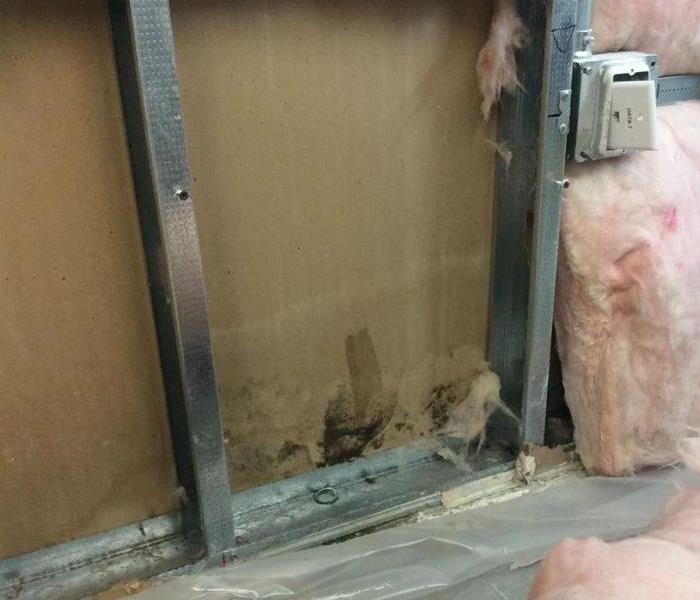 Mold discovered behind the drywall after being cut.
Mold discovered behind the drywall after being cut.
During an exceptionally busy weather pattern, our area of eastern Massachusetts saw several storms back-to-back. Just as you made headway cleaning up after one storm, another would come in to undo all all your progress. Such was the case with a local elementary school when a pipe burst, unleashing 30,000+ thousand gallons of water through the hallways.
As a normal course of our process, once the water is extracted, we cut the drywall above the water line to ensure no moisture continues to spread and lead to the growth of mold.
Unfortunately, upon doing this, we found evidence of old mold in some of the drywall. Although it was not a huge amount, it was enough to shut the school down for several days, displacing the students to temporary housing and causing guaranteed headaches for the parents.
The moral of this story is to do it the right way every time because in the end, you never avoid the work that needs to be done. SERVPRO of Danvers/Ipswich doesn't cut corners (unless it's wet drywall), when it comes to standards of operation.
Call the experts when water, fire or mold damage strikes.
Water Damage Can Leave An Unwanted Guest
1/23/2018 (Permalink)
After you have suffered through the disaster water damage can leave behind, you may sigh a breath of relief and think the worst is over. Unfortunately, if not mitigated correctly, the worst may be yet to come.
When it comes to water damage, they key to avoiding future mold problems is time. The quicker you can get to the source, fix the problem, and begin the drying (or demolition) the better.
Brian Carifio, a Project Estimator here at SERVPRO of Danvers/Ipswich, recommends waiting no longer than 3 days to address the mold risk.
He also recommends the following steps
Dry out the affected area. Once the water has been extracted, use fans and a dehumidifier to help dry out the area. If possible, open windows to allow for air circulation and faster drying. You want to dry the area out as soon as possible. If you have a finished basement and the drywall was affected, you’ll probably have to cut away the areas that were touched by water as the drywall will crumble and the paper backing is a good source of food for mold. If you have baseboard trim, take it up first, and if it’s made from pressboard it will likely not be salvageable. If it was wood, you might be able to save it.
Disinfect. This is a crucial step that is often overlooked. After the area has dried out, including wood beams, insulation, drywall, etc., use a good disinfectant to get rid of any bacteria that might have come up through sewers, toilets, etc. Disinfect all areas affected by the flood waters including walls and wood and non-upholstered furniture that sat in flood water.
SERVPRO of Danvers/Ipswich uses proprietary, OSHA-approved cleaning agents that may be needed to clean and remove odors and/or contaminants on your property.
- Deodorization products control odors from excessive moisture.
- Disinfection products stop the growth of bacteria, fungi, mildew, and other harmful microorganisms.
Dispose of damaged items responsibly: you’ll be tempted to throw everything into a dumpster and send it all away and out of site. But if you can organize damaged goods into piles and take what you can to recycling centers, you will help alleviate the pressure on your local landfill site. Go to your city or town’s waste management website to find out where to recycle old paints, stains, adhesives and other toxic liquids, any damaged electronics from cell phones to TVs and computers, furniture, and even drywall.
Mold Remediation Services
5/5/2017 (Permalink)
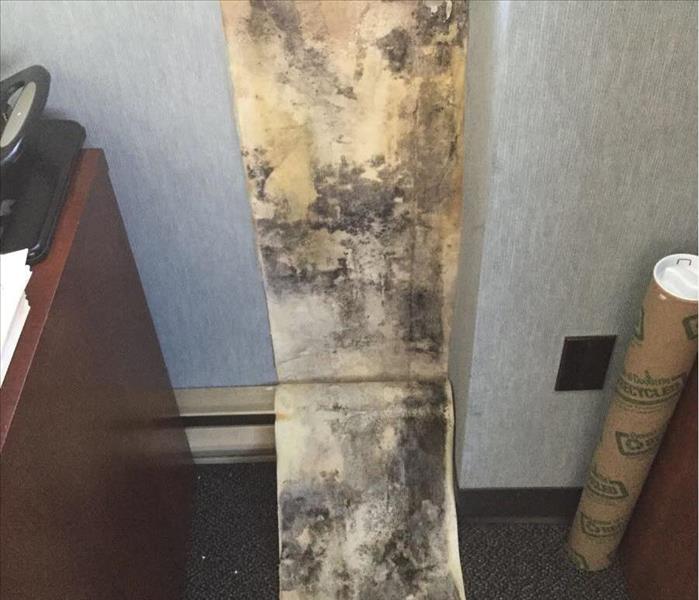 Mold was found in this Amesbury, MA office building and SERVPRO of Danvers/Ipswich remediated the mold.
Mold was found in this Amesbury, MA office building and SERVPRO of Danvers/Ipswich remediated the mold.
Does Your Ipswich Home Have A Mold Problem?
With window and doors open now, with the nice weather, many types of particles have free access to float into your home. Mold can spread through a home in as little as 48 hours.
Microscopic mold spores naturally occur almost everywhere, both outdoors and indoors. This makes it impossible to remove all mold from a home or business. Therefore, mold remediation reduces the mold spore count back to its natural or baseline level. Some restoration businesses advertise “mold removal” and even guarantee to remove all mold, which is a fallacy. Consider the following mold facts:
- Mold is present almost everywhere, indoors and outdoors.
- Mold spores are microscopic and float along in the air and may enter your home through windows, doors, or AC/heating systems or even hitch a ride indoors on your clothing or a pet.
- Mold spores thrive on moisture. Mold spores can quickly grow into colonies when exposed to water. These colonies may produce allergens and irritants.
- Before mold remediation can begin, any sources of water or moisture must be addressed. Otherwise, the mold may return.
- Mold often produces a strong, musty odor and can lead you to possible mold problem areas.
- Even higher-than-normal indoor humidity can support mold growth. Keep indoor humidity below 45 percent.
If your home or business has a mold problem, we can inspect and assess your property and use our specialized training, equipment, and expertise to remediate your mold infestation.
If You See Signs of Mold, Call Us Today – (978) 777-3498






 24/7 Emergency Service
24/7 Emergency Service









